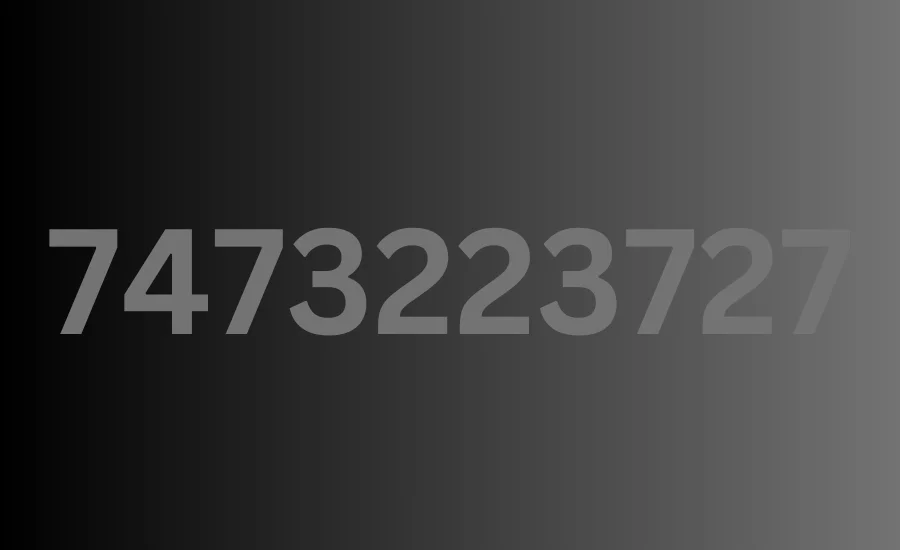Introduction
Cryptography, the art of secure communication, has long been a cornerstone in the fields of security, privacy, and defense. Among the multitude of codes and ciphers that have both mystified and challenged cryptographers over the years, the 7473223727 code stands out for its intricate structure and enigmatic nature. This article delves deep into the world of this code, exploring its complexity, the techniques used to attempt its decryption, and its potential cultural and symbolic significance.
Understanding Cryptographic Complexity: The Nature of the 7473223727 Code

At its core, the 7473223727 code represents more than just a random assortment of digits. Like many cryptographic puzzles, its essence lies in the deliberate transformation of readable data into an undecipherable format, an art that dates back to ancient civilizations but has evolved to become a sophisticated discipline in modern cybersecurity.
What Is Cryptography?
Cryptography involves encrypting plaintext (readable information) into ciphertext (unreadable format) using specific algorithms. The goal is to protect information from unauthorized access, ensuring that only individuals with the proper decryption key can access the original message. The complexity of the 7473223727 code suggests that it employs advanced cryptographic methods, which have kept it shrouded in mystery for years.
The Uniqueness of the 7473223727 Cipher
Unlike simple substitution ciphers, which swap letters or numbers according to a fixed system, the 7473223727 code likely incorporates layers of complexity. These could include patterns that are not immediately apparent, possibly even involving mathematical operations or positional significance, making it one of the most challenging codes to crack. This complexity hints at its potential use in high-security environments or as part of a larger encrypted communication system.
Numerological Perspectives: The 7473223727 Code and Its Symbolism
In addition to its cryptographic intrigue, the sequence 7473223727 holds significant meaning in numerology. Numbers often carry symbolic weight in various cultural and spiritual traditions, and the digits of this particular sequence are no exception.
Numerology and Its Interpretations
Numerology is the belief that numbers have inherent energies and can influence human life. When broken down, the individual digits of 7473223727—7, 4, 3, and 2—are associated with attributes such as introspection, stability, creativity, and partnership. When analyzed as a whole, the sequence might be seen as representing a complex blend of these energies, pointing to deeper meanings or purposes beyond the code itself.
7473223727 in Different Cultural Contexts
In both Eastern and Western numerological systems, numbers like 7 and 3 are often revered for their spiritual and mystical significance. For instance, in Eastern traditions, the number 7 is frequently linked to spiritual awakening and enlightenment, while in the West, it is considered a symbol of perfection or completeness. The appearance of these numbers within the 7473223727 sequence may suggest that its originators sought to encode not just data, but also layers of symbolic meaning that resonate across different belief systems.
Unraveling the Origins of the 7473223727 Code

The enigma of the 7473223727 code has fascinated cryptanalysts and amateur puzzle solvers alike. Its origins remain a mystery, with various theories circulating about its purpose, creators, and the context in which it was developed. By delving into the historical use of cryptography and examining potential scenarios in which such a code might have emerged, we can begin to uncover its possible significance.
Theories Behind the Creation of the 7473223727 Code
Elite Cryptographer Hypothesis
One leading theory is that the 7473223727 code was crafted by an elite cryptographer working for a highly secretive organization. In this scenario, the code could have been developed to protect highly sensitive information—perhaps for a government agency, military operation, or a covert group engaging in clandestine activities. Such codes are often created by cryptography experts using advanced algorithms to ensure they remain unbreakable by conventional means.
The sophistication of this theory lies in the assumption that only a select few would have access to the key necessary to decrypt the sequence. The 7473223727 code, if designed by a cryptographic mastermind, would reflect the use of cutting-edge techniques and a deep understanding of modern encryption systems.
Part of a Clandestine Communication Network
Another compelling hypothesis suggests that the 7473223727 code could be part of a broader, encrypted communication network. Similar to the methods used by intelligence agencies during the Cold War, this code might serve as a link in a chain of communications that are transmitted securely across various platforms. Such systems would require highly encrypted messages to maintain secrecy and prevent interception by adversaries.
This theory points to the possibility that the code is a single piece of a larger puzzle. Decrypting the code might reveal not just a message, but an entry point into a hidden network of communications used for covert exchanges.
Historical Use of Ciphers and Secret Codes
Cryptography in Ancient Civilizations
Cryptography is not a new practice. Throughout history, it has been used to secure important communications across various civilizations. The Ancient Greeks and Romans, for instance, used simple substitution ciphers such as the Caesar cipher to conceal military and political strategies. These early forms of encryption were designed to thwart enemies from intercepting critical information and turning the tide of war.
Much like the encrypted messages of ancient civilizations, the 7473223727 code may have been designed for a specific practical purpose: to hide information from those without the proper key to access it.
The Role of Codes in World War II
During World War II, the use of cryptography reached new heights with the development of the German Enigma machine. The Allies’ success in cracking Enigma was a turning point in the war and highlighted the critical role that codes played in modern warfare. With the aid of early computers and brilliant mathematicians like Alan Turing, encrypted Nazi communications were deciphered, giving the Allies a strategic advantage.
The 7473223727 code could be seen as a continuation of this legacy. Like Enigma, it may have been designed to protect vital information, whether in military operations, governmental secrets, or intelligence gathering.
Cold War Espionage and Coded Messages
During the Cold War, codes and ciphers became synonymous with espionage. Intelligence agencies on both sides of the Iron Curtain used advanced cryptographic techniques to safeguard classified information and communicate with spies. One famous example is the “Numbers Stations,” which broadcast seemingly random strings of numbers over shortwave radio, suspected to be encrypted messages to field agents.
The 7473223727 code may share similarities with these cryptic broadcasts, hinting at a connection to espionage or secret intelligence operations. If the code were used to communicate with operatives or to exchange top-secret information, its origins might lie in a modern-day intelligence or surveillance agency.
Modern Applications of Cryptography

Cybersecurity and Encrypted Networks
In today’s digital age, cryptography plays a central role in securing data across the internet. Encrypted networks protect everything from financial transactions to private communications. Advanced algorithms, such as RSA or AES encryption, are used to safeguard information from cybercriminals and malicious actors.
The 7473223727 code may be part of a modern cybersecurity protocol designed to protect sensitive data. In this context, the sequence could be a component of an encrypted network that guards against hacking or unauthorized access, making it a highly secure communication tool for an organization or individual.
Blockchain and Cryptographic Codes
The rise of blockchain technology has introduced new cryptographic applications, particularly in securing decentralized networks. Blockchain employs complex cryptographic techniques to create secure, immutable records of transactions. The use of cryptographic hash functions in blockchain has revolutionized how we think about digital security.
It’s possible that the 7473223727 code is linked to such technologies, perhaps serving as an access key, part of a cryptographic algorithm, or a tool for verifying the integrity of digital information within a blockchain system.
Deciphering the 7473223727 Code: Techniques and Challenges
Breaking a complex code like 7473223727 requires more than just luck—it demands a combination of advanced analytical techniques, patience, and sometimes even a touch of creativity.
Techniques for Decoding Complex Codes
Cryptanalysts employ various methodologies to crack challenging ciphers. Common techniques include frequency analysis (identifying how often certain symbols or numbers appear), pattern recognition, and brute-force attacks, where every possible solution is tested until the correct one is found. In the case of the 7473223727 code, however, these traditional methods have yet to yield a solution, suggesting that more advanced or unconventional strategies may be required.
Obstacles and Misdirections in Code Breaking
Codes like 7473223727 often contain intentional misdirections—false patterns or red herrings designed to confuse those attempting to decode them. These obstacles add an additional layer of difficulty, requiring analysts to carefully consider each potential solution and remain open to the possibility that the code may operate on entirely new principles.
Psychological and Cultural Impact: The Enigma of the 7473223727 Code
Aside from its cryptographic challenges, the 7473223727 code has captured the imagination of many. From conspiracy theories to psychological phenomena, the code has inspired various interpretations and speculations.
Conspiracy Theories and Public Fascination
As with many unsolved puzzles, the 7473223727 code has become the subject of numerous conspiracy theories. Some speculate that it may be linked to secret governmental operations, while others entertain the possibility that it is a message from extraterrestrial beings. Whether these theories hold any truth or are simply the product of speculation, they have added to the mystique surrounding the code.
Psychological Insights: Why Are We So Drawn to Complex Numbers?

Psychologists suggest that humans are naturally inclined to seek patterns, even in seemingly random sequences. This phenomenon, known as pareidolia, may explain why certain numbers like 7473223727 captivate public interest. Our inherent need to make sense of the world leads us to assign meaning to numbers, symbols, and patterns, even when they are devoid of obvious significance.
Learning from History: Code-Cracking Achievements and Their Relevance
The world of cryptography has long been filled with complex puzzles, and the 7473223727 code is no exception. While this sequence presents modern cryptanalysts with a formidable challenge, history offers valuable insights into how past code-breaking triumphs can inform today’s efforts. Examining these historical achievements not only provides inspiration but also uncovers the strategies and techniques that may prove effective in decoding this contemporary enigma.
Famous Code-Cracking Successes
The Decryption of the Enigma Code
One of the most significant breakthroughs in cryptographic history is the decryption of the German Enigma machine during World War II. The success of British mathematician Alan Turing and his team at Bletchley Park stands as a testament to the power of collaboration, ingenuity, and perseverance.
The Enigma machine was used by Nazi Germany to encrypt its military communications, with the belief that the codes it generated were unbreakable. However, Turing’s group, utilizing a combination of mathematical insight and early computing technology, managed to crack the code. This breakthrough not only shortened the war but also laid the foundation for modern cryptanalysis.
The lessons from the Enigma code-breaking effort highlight the importance of teamwork, persistence, and a multi-disciplinary approach. Much like the challenge posed by the 7473223727 code, the Enigma machine seemed unsolvable at the time, but determination and innovation ultimately led to its unraveling.
The Zodiac Killer Ciphers

Another famous example of cryptographic history is the Zodiac Killer’s ciphers, which have perplexed both amateur and professional cryptanalysts for decades. While not all of the Zodiac ciphers have been decoded, partial solutions have been uncovered, demonstrating the resourcefulness and creativity required to solve complex cryptographic puzzles.
The persistence of those working to crack the Zodiac ciphers mirrors the ongoing efforts to decode the 7473223727 sequence. Despite many attempts, only a portion of the Zodiac’s cryptic messages have been solved, emphasizing that some codes require long-term commitment and the application of diverse techniques.
Modern Implications of Historical Code Breaking
The historic achievements of code breakers like Turing and those working on the Zodiac ciphers remind us that even the most complex codes can eventually be solved with the right combination of tools, strategies, and determination. These past successes offer a blueprint for tackling the 7473223727 code, encouraging modern cryptanalysts to apply both advanced technology and creative thinking in their efforts.
While today’s digital codes may involve more intricate algorithms and advanced encryption techniques, the underlying principles of cryptography have not changed. The lessons from historical code breaking underscore the importance of adaptability and the ongoing evolution of cryptanalytic methods. Just as past cryptographers evolved their approaches in response to new challenges, modern experts must continue to innovate in the face of emerging cryptographic obstacles.
Collaborative Efforts and Technological Advancement
The importance of teamwork in cryptanalysis cannot be overstated. In the case of the Enigma machine, the combined efforts of mathematicians, engineers, and codebreakers were crucial to achieving success. Similarly, future breakthroughs in cryptography will likely depend on interdisciplinary collaboration, combining the expertise of mathematicians, computer scientists, and even psychologists to understand and decode intricate sequences like 7473223727.
As technology continues to advance, cryptanalysts have access to increasingly powerful tools. Quantum computing, in particular, holds the potential to revolutionize the field, enabling the processing of vast amounts of data and speeding up the code-cracking process. However, these advances also introduce new challenges, as cryptographers must develop encryption techniques that are resistant to quantum-based attacks.
The Enduring Spirit of Code Breaking

Historical code-cracking achievements provide both technical lessons and philosophical insights. Whether it was Turing’s victory over the Enigma machine or the continued efforts to solve the Zodiac ciphers, these examples remind us of the enduring human capacity for problem-solving. The 7473223727 code, like many puzzles before it, is a test of both skill and patience.
By studying the successes and strategies of the past, modern cryptanalysts can better position themselves to tackle current challenges. The future of code breaking will undoubtedly involve a blend of technology, creativity, and human perseverance—key ingredients that have defined the field throughout history.
The Future of Cryptography: Quantum Computing and Code Cracking

As technology advances, the landscape of cryptography is evolving. Quantum computing, in particular, is poised to revolutionize the field of code-breaking, presenting both opportunities and challenges.
How Quantum Computing May Change Cryptography
Quantum computers can process enormous amounts of data at unprecedented speeds, making them a potential game-changer in the realm of cryptanalysis. While this technology could make breaking codes like 7473223727 easier, it also threatens to undermine current encryption methods, necessitating the development of new quantum-resistant cryptographic techniques.
Facts
- Origins: The 7473223727 code is known for its cryptic nature, but its origin remains unclear. It is often cited in various cryptographic discussions for its complexity.
- Structure: The code is a sequence of digits, but whether these numbers represent letters, symbols, or other encoded data has been a subject of debate among cryptography enthusiasts.
- Attempts at Decryption: Numerous decryption techniques, including classical ciphers (like Caesar or Vigenère), as well as more advanced cryptographic methods (like RSA or AES), have been used in attempts to crack the code, though no conclusive solution has emerged.
- Theories and Hypotheses: Some theorists suggest that the code may contain cultural or symbolic significance beyond simple encryption, possibly representing a key date, word, or message within a specific context.
- No Known Cipher: Despite various efforts, no known cipher has yet matched the 7473223727 sequence, further deepening the mystery and intrigue surrounding it.
- Speculative Origin: The code has often been associated with online cryptographic puzzles or hidden messages in digital platforms, but no verifiable source links it to any specific historical context.
FAQs
Q1: What is the 7473223727 code?
A: The 7473223727 code is a cryptic numerical sequence that has confounded cryptographers due to its complexity and unknown origins.
Q2: Has anyone decrypted the 7473223727 code?
A: No. To date, no one has successfully decrypted the code despite various attempts using both classical and modern cryptographic techniques.
Q3: What does the code represent?
A: The exact meaning of the 7473223727 code is unknown, but it is hypothesized to have cultural, symbolic, or cryptographic significance.
Q4: Why is the 7473223727 code important?
A: Its importance lies in the mystery surrounding it. It has intrigued cryptography enthusiasts and sparked numerous decryption attempts, making it a noteworthy example in the study of cryptography.
Q5: Could this code be part of a larger puzzle?
A: It’s possible. Some speculate that the 7473223727 code may be part of a broader cryptographic puzzle or an alternate reality game (ARG).
Related: 447220-4771
Conclusion
The 7473223727 code remains one of cryptography’s unsolved mysteries. Despite extensive attempts at decryption using a wide range of techniques, its meaning and purpose have yet to be unlocked. The ongoing intrigue surrounding the code highlights the enduring allure of cryptography and the quest for secure, hidden communication. Whether the code is a piece of a larger puzzle, an encryption from history, or something entirely different, it continues to challenge the boundaries of cryptographic knowledge and keeps enthusiasts searching for the key to its solution.
Don’t miss out on updates and alerts – stay connected! Essential Discover.





